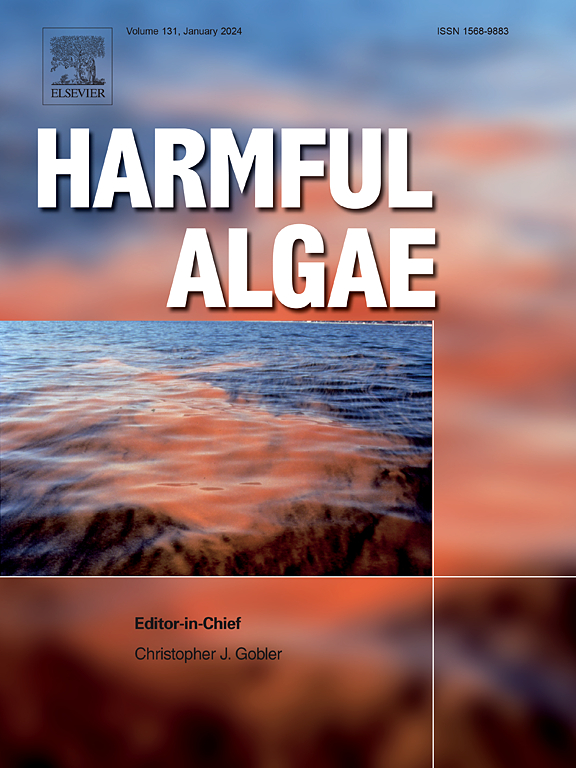捕食者诱导的防御降低了有毒硅藻的生长速度和承载能力
IF 4.5
1区 生物学
Q1 MARINE & FRESHWATER BIOLOGY
引用次数: 0
摘要
浮游植物采用各种各样的防御措施来减少浮游动物捕食造成的死亡率。许多这样的防御是诱导的,也就是说,它们在捕食增加的情况下被上调。因此,理论预测,它们应该以生物体的代价为代价。当暴露于桡足类捕食者的捕食线索时,硅藻伪nitzschia seriata上调神经毒素软骨藻酸(DA)的产生。最近发现DA对食草动物有威慑作用,但它的生产是否有代价尚不清楚。在本研究中,我们将一株p.s seriata暴露于桡足动物的线索中,诱导其在种群生长阶段增加DA的产量。我们发现,诱导细胞不仅生长缓慢,而且因为它们从培养基中吸收了更多的氮,所以它们产生的细胞总数更少。1%的细胞氮用于生产DA,这表明较低的生长速度并不反映直接的分配成本,而是细胞操纵生长速度以达到更高的每个细胞的毒素含量,或者与更高的毒素负荷相关的其他成本。这种对浮游植物权衡的机械理解对于准确描述和模拟海洋浮游生物动力学至关重要。本文章由计算机程序翻译,如有差异,请以英文原文为准。
Predator-induced defense reduces growth rate and carrying capacity in a toxic diatom, Pseudo-nitzschia seriata
Phytoplankton employ a wide variety of defenses to reduce mortality from zooplankton grazing. Many such defenses are inducible, that is, they are upregulated in the event of increased predation. Thus, theory predicts that they should come at a cost to the organism. When exposed to predatory cues from a copepod predator, the diatom Pseudo-nitzschia seriata upregulates the production of the neurotoxin domoic acid (DA). DA has recently been found to have grazer deterrent effects, but whether its production comes with trade-offs is still unclear. Here, we expose a strain of P. seriata to cues from copepods to induce increased DA production through the population growth phases. We find that not only do the induced cells grow slower, but because they take up more nitrogen per cell from the media, they produce less cells overall. <1 % of cellular nitrogen went into DA production, suggesting that the lower growth rate does not reflect a direct allocation cost, but rather that cells manipulate growth rate to reach higher toxin content per cell, or other costs associated with a higher toxin load. Such a mechanistic understanding of phytoplankton trade-offs is essential to accurately describe and model ocean plankton dynamics.
求助全文
通过发布文献求助,成功后即可免费获取论文全文。
去求助
来源期刊

Harmful Algae
生物-海洋与淡水生物学
CiteScore
12.50
自引率
15.20%
发文量
122
审稿时长
7.5 months
期刊介绍:
This journal provides a forum to promote knowledge of harmful microalgae and macroalgae, including cyanobacteria, as well as monitoring, management and control of these organisms.
 求助内容:
求助内容: 应助结果提醒方式:
应助结果提醒方式:


